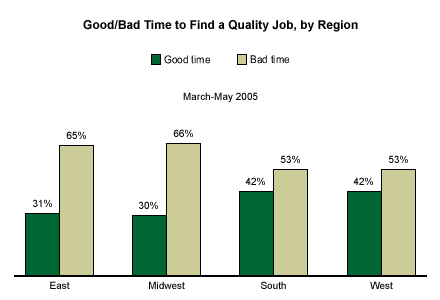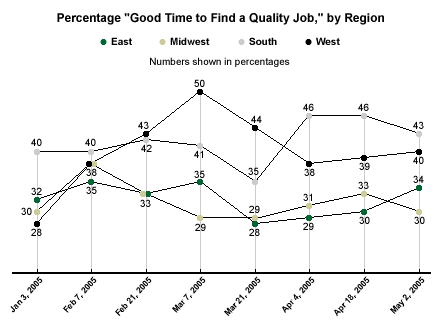Twice each month, ║┌┴¤═° updates Americans' perceptions of the job market by asking the public if it is now a "good or bad time to find a quality job." Americans are generally more pessimistic than optimistic about current job prospects, but their views are more positive now than in recent years. A closer look at the data shows consistent regional variation in assessments of the job market this year, with those in the West and the South more optimistic than those in the East and the Midwest.
According to an aggregate of ║┌┴¤═° data since March*, 31% of those residing in the East and 30% of those residing in the Midwest say it is a good time to find a quality job. By comparison, 42% of those in the South, and 42% of those in the West, say it is a good time.

These relationships persist even when controlling for other factors that are related to job market assessments, including partisanship, income, and employment status. And the differences are not necessarily reflections of differential ratings of the economy by region -- while perceptions of the national economy vary somewhat by region, these gaps are not as large as the gaps by region in job market assessments.
Ratings of National Economy, by Region, March-May 2005
|
|
East |
Midwest |
South |
West |
|
Rate economy as excellent or good |
29% |
32 |
36 |
34 |
|
Say economy is getting better |
32% |
34 |
36 |
36 |
The trends show that perceptions of the job market weren't all that different in January and especially February. Divergence was first evident in late February and has persisted since. In the West, job market assessments improved in each poll from early January to early March, and have leveled off somewhat since. In the South, a slightly different pattern is evident, with ratings of the job market higher in the three most recent months than at earlier points in the year. The trends in the East and Midwest have been relatively flat, especially in the last two months.

The regional differences in job market perceptions are generally in line with regional estimates of employment provided by the Bureau of Labor Statistics in its May 20 report. For example, the biggest gains this year in nonfarm employment have been in Nevada, Arizona, Utah, Oregon, and Florida -- four Western states and one Southern state. The Midwest generally had the highest level of unemployment this year (while the Northeast has the lowest unemployment rate, none of the states in the region show significant job growth).
║┌┴¤═°'s new May 23-26 poll suggests stability in ratings of the job market at the national level, with slightly fewer than 4 in 10 Americans saying it is a good time to find a quality job (as has been the case since February, save for a slightly lower 34% reading in mid-March). Those data suggest that Midwest residents may be rating the job market more positively now, but still behind those of the South and West, while Eastern residents continue to give substantially more negative ratings.
*Results are based on an aggregate of 5,023 telephone interviews with randomly selected national samples of adults, age 18 and older, conducted March 7-May 5, 2005.
For results based on the 1,150 residents of the East, 1,136 residents of the Midwest, 1,614 residents of the South, and 1,123 residents of the West, the maximum margins of sampling error are ┬▒3 percentage points.